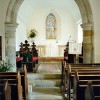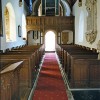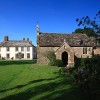Dorset farmers with a firm footing in the 18th century were not usually the kind of people known for their erudition. After all, for anyone running a farm this was an age of illiteracy and poverty; any schooling, where it existed at all, would have been very elementary. However, there were a few notable exceptions to this rule. One such person was Samuel Crane.
Crane was born near Bere Regis in 1746, one of eight children and the elder son of John and Elizabeth Crane. Of the younger son George, little is known but it is known that Sam was able to benefit from a well-rounded education, since it was noted that his handwriting was distinctly legible and precise. Probably from his father, he gained knowledge and instruction in practical husbandry and farm management. These attainments would serve him well in the years to come.
While Samuel was still a young man a wealthy landowner called Jocelyn Pickard came into the possession of Bloxworth House in the parish of Bloxworth near Bere. The house was the focus of an extensive estate of farmland which, with the exception of the northern part, was owned by the Lytchett Matravers branch of the manorial Trenchard family. Pickard had secured his tenure of the estate by marrying George and Mary Trenchard’s daughter Henrietta in 1751. At the time the best land on the estate lay to the north, where the bedrock was chalk, while to the south was a narrow belt of clay mostly suitable for pasture with some crops. Some yeoman farmers had smallholdings here.
Needing a farm/estate manager Pickard appointed Crane to the position soon after taking up residence at Bloxworth. But Samuel wasn’t just concerned with carrying out his duties. Possibly upon the instructions of his superior he began to keep what would eventually become at least two farm diaries: the first, covering the period from June 14th 1770 to August 10th 1771; the second, from February 1st 1781 to November 30th 1783. These records have proved to be of great value as sources of information about managing of the agricultural estate of an 18th century country house.
It is thought, therefore, that Crane probably arrived at Bloxworth House before beginning the first diary. Pickard was clearly eager to increase the estates’s value by ensuring that the farm was a success. However, entries in the 1781 to 1783 diary show obvious signs of some alterations being made in the style and content, suggesting Pickard was wielding some influence upon the content of what Crane wrote.
In 1771, the year the first diary was completed, Sam Crane married Jane Perrott at Hermitage, some 12 miles north of Dorchester. A faded, barely legible entry of a baptism on October 25th 1772 in on of the parish registers suggests that by this date the couple had a son, though no further or later records relating to him have ever been found. No less obscure has been the fate of Jane herself, who early disappears from the records, leaving behind her abiding mystery unresolved to this day.
While the Crane diaries furnish a wealth of detail about the day-to-day nuts and bolts of his managerial labours at Bloxworth, they are much less informative about personal details. For example, Sam did not record where he lodged at the time, though it is believed he lived in a large farmhouse in the part of the parish known as Newport. Otherwise, in these pages it is possible for the reader to compare changes in the organisation of the farm over a ten-year period – a time covering a recession when the estate workers experienced great hardship.
Samuel recorded the wages paid to the workers, though never his own. The wages include details of labour costs, staff numbers, and occupations, and it was a measure of Crane’s skill that the wage bill was brought down by almost 5% despite an increase in the size of the farm and in the amount of time worked. By March 1771, he wrote, he had increased the dairy heard, and during the writing of the first diary, the number of sheep increased to 1,100. Wheat and barley were sold for profit and cereals were also grown to supply the manor and to sell off to the farm workers. Details of wheat deliveries to the mill are also noted. In June 1771, Crane borrowed horses from two other yeoman farmers.
Also to emerge from the diaries is the fact that children were regularly employed as part of the workforce, though girls were not made to work until they were twelve. By 1782 ten men and four boys were employed on the Bloxworth farm. In that year too, five fields of hay were mown and by the 1780’s Crane had increased the size of the turnip crop. For a time, Sam had dealings with a man in Wolverton he called “my brother” selling turnip seeds and barley. Some buck wheat was bought in August 1782, but what it was used for is not recorded.
Domestic arrangements at the manor were largely in the hands of Henrietta Pickard, so that Sam had little involvement in the running of the house. His remit was limited to securing farm produce, furze, turf, hay, corn and coal. Routinely, Crane undertook journeys on horseback to make deliveries of corn.
Then soon after 1783 everything changed for Sam Crane. He left Bloxworth, his last diary entry being for November 30th that year. On August 28th, 1788 at Cerne Abbas, he married Elizabeth Davis and settled in that parish. The couple had four sons of which two, Samuel (born 1790) and James (born 1792) survived to adulthood. The eldest and youngest sons died in infancy.
In 1787 an uncle of Sam Crane – also named Samuel – had died at Alton Pancras in the Piddle valley, leaving his nephew a legacy of land called Mill Grounds at Buckland Newton and a residue of £1,700. Uncle Sam Crane, although twice married, had no surviving children so his nephew became the principal beneficiary.
Although his uncle’s will meant that Samuel was comfortably off, it is not certain whether he had any other sources of income. There is also no record of his salary as a farm manager at Bloxworth, and whether this included accommodation and food. Since by now his diary keeping had ceased, there are no details of how Sam earned a living after his move to Cerne.
Samuel Crane died in 1815, aged 69. Whatever income Elizabeth was able to provide, the time in which she could have applied it was very brief, as she followed her husband to the grave only three months later, leaving an estate worth £35,000. Today Samuel and Elizabeth lie together in Cerne Churchyard.
The following year Sam Jr and James married, at Compton Valence, women who may have been sisters. Samuel married Jane Davis and made his marital home at Godmanston; the couple’s only child died of tuberculosis at the age of 25. James married Charlotte Davis that June.



